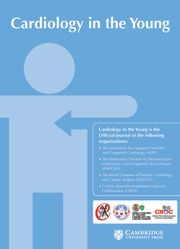Article contents
Abnormalities in pulmonary function and volumes in patients with CHD: a systematic review
Published online by Cambridge University Press: 05 January 2023
Abstract
Lung function and cardiac function are naturally correlated by sharing the thoracic cage and handling the whole cardiac output sequentially. However, lung function studies are rare in patients with CHD, although results worthy of investigation could be expected. This review summarises existing studies with the lung function parameters (spirometry and body plethysmography) in CHD patients during the last decade.
A systematic review was performed in the relevant database (PubMed, Cochrane, and Scopus) in studies including paediatric and adult patients with CHD where lung parameters (spirometry, body plethysmography) were investigated from January 2010 to December 2020. Two independent reviewers evaluated the studies according to the Study Quality Assessment Tool for Observational Cohort and Cross-Sectional Studies of the National Heart, Lung, and Blood Institute
Eight studies investigated patients with Fontan palliation including 704 patients (306 female). Four studies included patients after repaired tetralogy of Fallot examining 219 patients (103 female), with one study using double. Further six studies included 3208 (1324 female) children and adults with various CHDs. Overall, four studies were categorised as “good”, ten as “fair”, and four as “poor”. While the measurements were consistently standardised, references to calculate %predicted differed substantially across all studies. All evaluated studies showed reduced forced vital capacity in the majority of CHD patients.
Many CHD patients have a reduced forced vital capacity independent of their underlying defect. Spirometry should not only follow a standardised measure according to ATS (update 2019) but also stick to the 2012 GLI reference values
Information
- Type
- Review
- Information
- Copyright
- © The Author(s), 2023. Published by Cambridge University Press
References
A correction has been issued for this article:
- 5
- Cited by
Linked content
Please note a has been issued for this article.


